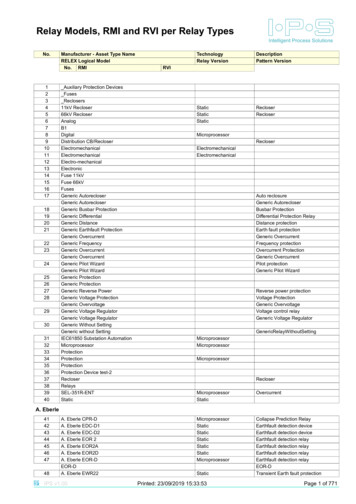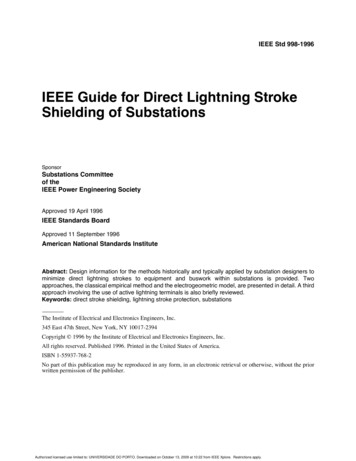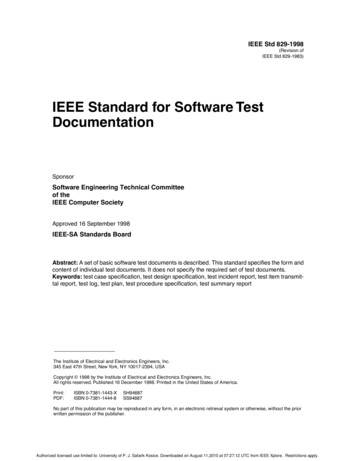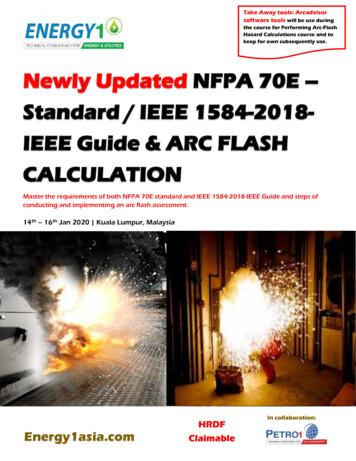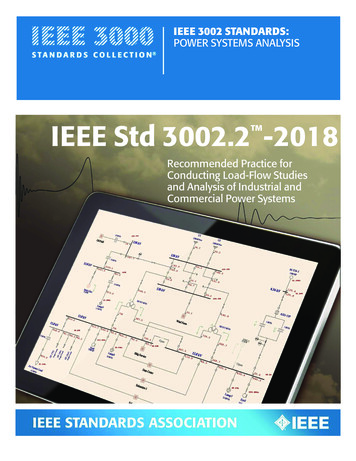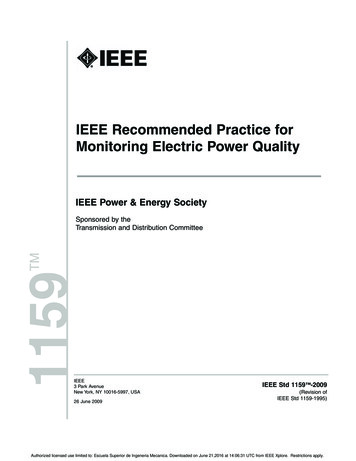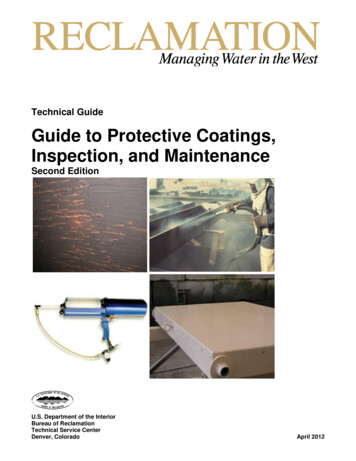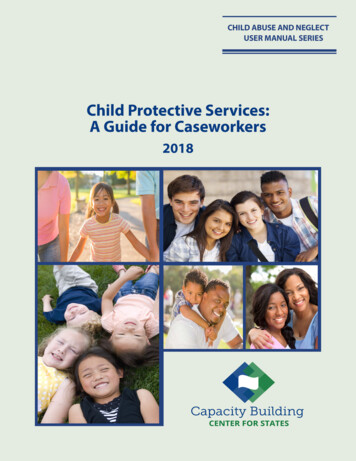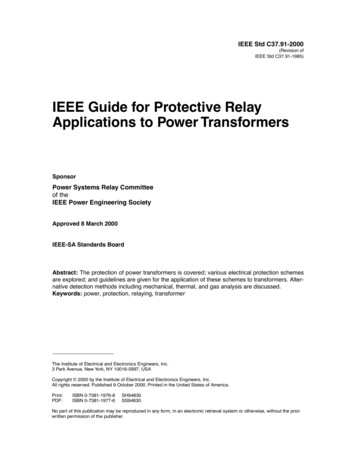
Transcription
IEEE Std C37.91-2000(Revision ofIEEE Std C37.91-1985)IEEE Guide for Protective RelayApplications to Power TransformersSponsorPower Systems Relay Committeeof theIEEE Power Engineering SocietyApproved 8 March 2000IEEE-SA Standards BoardAbstract: The protection of power transformers is covered; various electrical protection schemesare explored; and guidelines are given for the application of these schemes to transformers. Alternative detection methods including mechanical, thermal, and gas analysis are discussed.Keywords: power, protection, relaying, transformerThe Institute of Electrical and Electronics Engineers, Inc.3 Park Avenue, New York, NY 10016-5997, USACopyright 2000 by the Institute of Electrical and Electronics Engineers, Inc.All rights reserved. Published 9 October 2000. Printed in the United States of America.Print:PDF:ISBN 0-7381-1976-8ISBN 0-7381-1977-6SH94830SS94830No part of this publication may be reproduced in any form, in an electronic retrieval system or otherwise, without the priorwritten permission of the publisher.
IEEE Standards documents are developed within the IEEE Societies and the Standards Coordinating Committees of the IEEE Standards Association (IEEE-SA) Standards Board. Members of the committees servevoluntarily and without compensation. They are not necessarily members of the Institute. The standardsdeveloped within IEEE represent a consensus of the broad expertise on the subject within the Institute aswell as those activities outside of IEEE that have expressed an interest in participating in the development ofthe standard.Use of an IEEE Standard is wholly voluntary. The existence of an IEEE Standard does not imply that thereare no other ways to produce, test, measure, purchase, market, or provide other goods and services related tothe scope of the IEEE Standard. Furthermore, the viewpoint expressed at the time a standard is approved andissued is subject to change brought about through developments in the state of the art and commentsreceived from users of the standard. Every IEEE Standard is subjected to review at least every five years forrevision or reaffirmation. When a document is more than five years old and has not been reaffirmed, it is reasonable to conclude that its contents, although still of some value, do not wholly reflect the present state ofthe art. Users are cautioned to check to determine that they have the latest edition of any IEEE Standard.Comments for revision of IEEE Standards are welcome from any interested party, regardless of membershipaffiliation with IEEE. Suggestions for changes in documents should be in the form of a proposed change oftext, together with appropriate supporting comments.Interpretations: Occasionally questions may arise regarding the meaning of portions of standards as theyrelate to specific applications. When the need for interpretations is brought to the attention of IEEE, theInstitute will initiate action to prepare appropriate responses. Since IEEE Standards represent a consensus ofall concerned interests, it is important to ensure that any interpretation has also received the concurrence of abalance of interests. For this reason, IEEE and the members of its societies and Standards CoordinatingCommittees are not able to provide an instant response to interpretation requests except in those cases wherethe matter has previously received formal consideration.Comments on standards and requests for interpretations should be addressed to:Secretary, IEEE-SA Standards Board445 Hoes LaneP.O. Box 1331Piscataway, NJ 08855-1331USANote: Attention is called to the possibility that implementation of this standard mayrequire use of subject matter covered by patent rights. By publication of this standard,no position is taken with respect to the existence or validity of any patent rights inconnection therewith. The IEEE shall not be responsible for identifying patents forwhich a license may be required by an IEEE standard or for conducting inquiries intothe legal validity or scope of those patents that are brought to its attention.IEEE is the sole entity that may authorize the use of certification marks, trademarks, or other designations toindicate compliance with the materials set forth herein.Authorization to photocopy portions of any individual standard for internal or personal use is granted by theInstitute of Electrical and Electronics Engineers, Inc., provided that the appropriate fee is paid to CopyrightClearance Center. To arrange for payment of licensing fee, please contact Copyright Clearance Center, Customer Service, 222 Rosewood Drive, Danvers, MA 01923 USA; (978) 750-8400. Permission to photocopyportions of any individual standard for educational classroom use can also be obtained through the Copyright Clearance Center.
Introduction(This introduction is not part of IEEE Std C37.91-2000, IEEE Guide for Protective Relay Applications to PowerTransformers.)This is a revision of IEEE Std C37.91-1985, IEEE Guide for Protective Relay Applications to Power Transformers. This guide will aid in the effective application of relays and other devices for the protection ofpower transformers.In this revision several areas have been improved. Most notably:— Several figures were corrected.— Subclauses 5.5.2 and 6.2.3 on current inrush were rewritten to include a new form of inrush restraint.— Current transformer connections were updated in 5.4 to be in line with IEEE Std C37.110-1996,IEEE Guide for Application of Current Transformers Used for Protective Relaying Purposes.— Geomagnetic influence on transformers and protective relays is discussed in Clause 13.— Clause 11, Gas analysis, was revised to reflect current philosophy and practice.ParticipantsAt the time this guide was completed, the Working Group on Protective Relay Applications to Power Transformers had the following membership:Roger Hedding, ChairRobert Haas, Vice ChairRichard F. AngleGraham CloughStephen P. ConradMark ConroyClifford DownsVern DvorakCopyright 2000 IEEE. All rights reserved.Philip EngelStephen E. GrierHans Heining-TriebsJohn J. HorwathBarry JacksonHardy J. KingBradley D. NelsonMiriam P. SandersGerry SchmittJames E. StephensMalcolm SwansonJerome B. WilliamsMurty V. Yallaiii
The following members of the balloting committee voted on this standard:Richard F. AngleJohn AppleyardRobert W. BeckwithStuart BorlaseJohn BoyleJohn BurgerJeffrey A. BurnworthDaniel CarreauCarlos H. CastroSimon R. ChanoStephen P. ConradCarey J. CookRobert W. DempseyClifford DownsPaul R. DrumWalter ElmoreAhmed ElneweihiPhilip EngelJonathan D. GardellTony GiulianteStephen E. GrierRobert W. HaasRoy E. HartIrwin O. HasenwinkleRoger A. HeddingCharles F. HenvilleJerry W. HohnDennis K. HolsteinStanley H. HorowitzJohn J. HorwathJames D. Huddleston, IIIJames W. InglesonBarry JacksonHerbert JacobiCarl KinsleyJoseph L. KoepfingerW. C. KotheimerSture O. R. LindahlWilliam LoweW. J. Marsh, Jr.Michael J. McDonaldJeffrey L. McElrayGary L. MichelGeorge R. NailBradley D. NelsonGeorge C. ParrRobert D. PettigrewRadhakrishna V. RebbapragadaMohindar S. SachdevMiriam P. SandersTarlochan SidhuVeselin SkendzicPeter A. SolanicsKevin A. StephanJames E. StephensRichard P. TaylorJames S. ThorpDonald R. VolzkaCharles L. WagnerWilliam P. WaudbyJerome B. WilliamsDonna WilliamsMurty V. YallaJohn A. ZippStan ZochollThis standard is dedicated to the memory of Graham Clough, who passed away during the final stages ofpreparation of this document. He will be remembered for his contributions to this document and his serviceto the relay industry.When the IEEE-SA Standards Board approved this standard on 8 March 2000, it had the followingmembership:Richard J. Holleman, ChairDonald N. Heirman, Vice ChairJudith Gorman, SecretarySatish K. AggarwalDennis BodsonMark D. BowmanJames T. CarloGary R. EngmannHarold E. EpsteinJay Forster*Ruben D. GarzonLouis-François PauRonald C. PetersenGerald H. PetersonJohn B. PoseyGary S. RobinsonAkio TojoHans E. WeinrichDonald W. ZipseJames H. GurneyLowell G. JohnsonRobert J. KennellyE. G. “Al” KienerJoseph L. Koepfinger*L. Bruce McClungDaleep C. MohlaRobert F. Munzner*Member EmeritusAlso included is the following nonvoting IEEE-SA Standards Board liaison:Robert E. HebnerNoelle D. HumenickIEEE Standards Project EditorivCopyright 2000 IEEE. All rights reserved.
Contents1.Overview. 11.1 Scope. 11.2 Purpose. 12.References. 13.Philosophy and economic considerations . 24.Types of transformer failures. 35.Relay current. 45.15.25.35.45.56.Electrical detection of faults . 76.16.26.36.46.56.66.76.87.Minimum internal faults . 4Maximum internal faults. 4Through-faults. 4Performance of CTs . 5Reasons for mismatch current. 6Fuse protection. 8Differential protection. 10Overcurrent relay protection . 18Ground fault protection. 21Fault detection for special-purpose transformers. 23Backup and external fault protection . 29Temperature relays. 31Miscellaneous relays. 31Mechanical detection of faults . 317.1 Gas accumulator relay. 317.2 Gas detector relay . 327.3 Pressure relays . 328.Thermal detection of abnormalities . 348.1 Thermal relays for winding temperature. 348.2 Other means of thermal protection . 358.3 Testing thermal relays. 389.Fault clearing . 389.19.29.39.49.59.6Relay tripping circuits. 39Circuit breakers. 39Remote tripping of circuit breakers . 39Circuit switcher. 40Fuses . 40Other practices . 40Copyright 2000 IEEE. All rights reserved.v
10.Reenergizing practice. 4111.Gas analysis . 4212.Special protective schemes . 4212.1 Overall unit generator differential .
IEEE Std C57.12.00-2000, IEEE Standard General Requirements for Liquid-Immersed Distribution, Power, and Regulating Transformers. IEEE Std C57.91-1995, IEEE Guide for Loading Mineral-Oil-Immersed Transformers.
